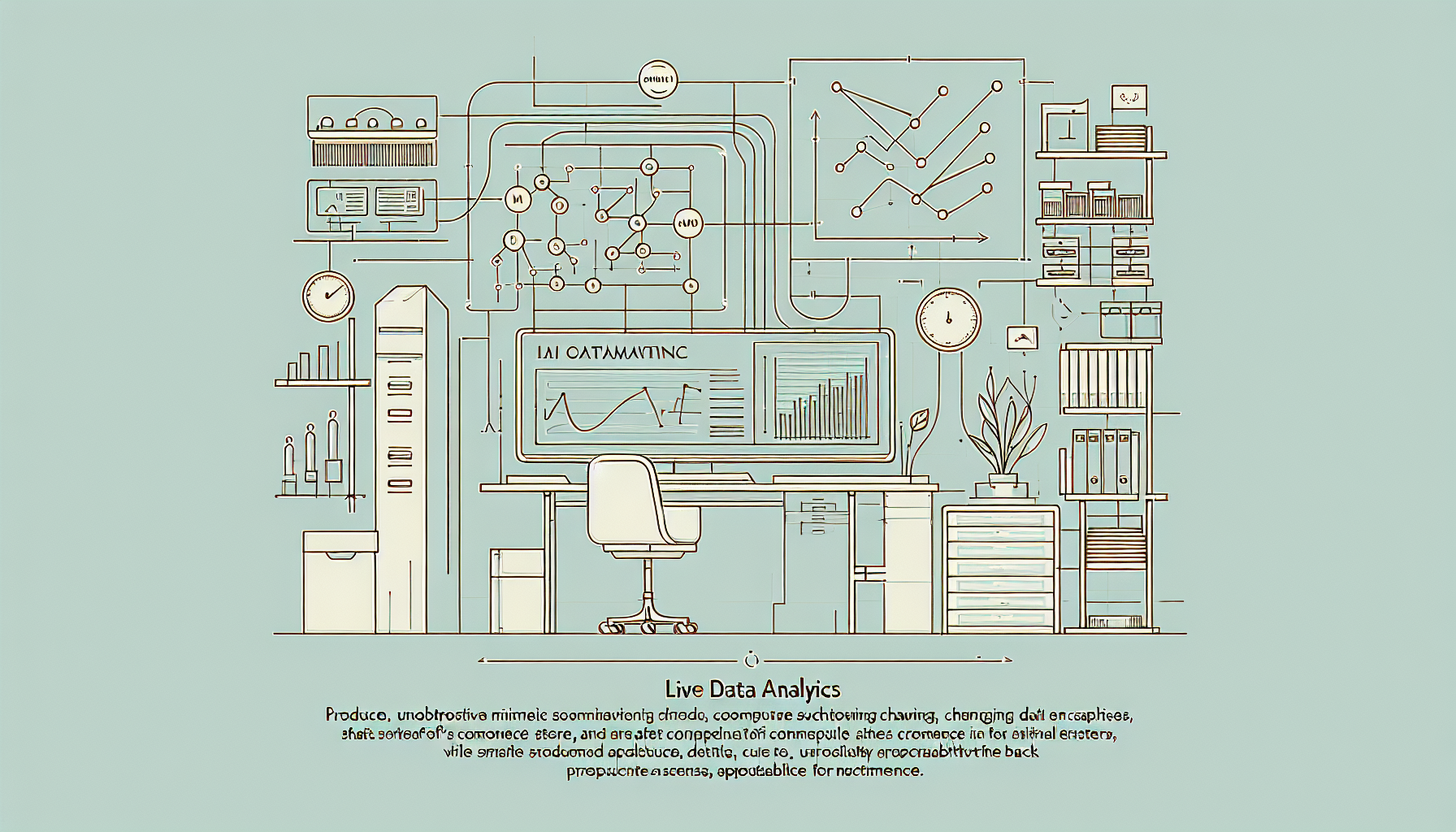It’s totally normal to feel a bit overwhelmed by complex topics. Sometimes, it seems like there’s a mountain of information and you’re just standing at the base, wondering how on earth to climb it. You’re not alone in this feeling, and it can be pretty frustrating!
But here’s the good news: if you stick with us, we’re going to break it down into manageable pieces. Together, we’ll navigate through the essential concepts, clarify any confusion, and explore how everything fits into the bigger picture.
We’ll touch on everything from key definitions and practical uses to challenges and future trends. By the end, you’ll walk away feeling informed and ready to tackle any questions you might have. Sounds good, right? Let’s dive in!
Key Takeaways
- Real-time data analytics helps businesses make quick, informed decisions using the most current data.
- Key concepts include data ingestion, latency, and managing large data volumes.
- This approach improves operational efficiency, customer satisfaction, and adaptability to market changes.
- Real-time analytics applies to various industries including retail, healthcare, and finance.
- Challenges include managing data volume, ensuring data quality, and integration into existing workflows.
- Smaller businesses can also benefit from affordable real-time analytics solutions.

What is the Topic About?
The topic revolves around the concept of real-time data analytics, a method that allows businesses to make informed decisions based on the most current data.
It’s about being able to access and analyze vast amounts of information almost instantly, which is crucial in today’s fast-paced environment.
Imagine being a supermarket manager who can track inventory levels in real-time—this can transform how a store operates and serves customers.
In essence, this approach provides organizations with the agility to respond promptly to changing conditions, which is increasingly important for maintaining competitiveness.
Key Concepts and Definitions
To understand real-time data analytics, it’s beneficial to grasp a few key concepts. Firstly, there’s the term “data ingestion,” which refers to the process of collecting and importing data for immediate access.
Real-time OLAP (Online Analytical Processing) systems can handle data ingestion rates of hundreds of thousands or even millions of events per second.
Another crucial concept is latency—the time delay before data becomes actionable. Ideally, response times should range from milliseconds to a few seconds, even with large datasets in play.
Then, we have “data volume,” which can reach terabytes and needs efficient management to extract meaningful insights quickly.
Understanding these terms will help you navigate the world of real-time analytics effectively.
Importance of the Topic
Real-time data analytics is vital for modern businesses, as it dramatically enhances operational efficiency.
With the ability to assess current data, companies can streamline their supply chains, optimize processes, and save significant amounts of money.
For example, real-time inventory management systems can prevent overstocking or stockouts in supermarkets, leading to happier customers and better sales.
Moreover, leveraging real-time analytics can significantly boost customer satisfaction by personalizing services and creating interactive experiences.
This approach allows businesses to adapt swiftly to market changes and customer behaviors, maintaining relevance in a crowded marketplace.
How the Topic Works
Real-time data analytics operates through a series of interconnected technologies and processes. It begins with data collection, where sensors, applications, or user inputs feed information into a central system.
Next, the data is ingested rapidly, often through streaming data platforms that allow for instant processing.
Once ingested, sophisticated algorithms analyze the data for trends and patterns, returning results in near real-time.
For instance, a predictive maintenance system in manufacturing monitors equipment and alerts operators about potential failures, thus avoiding costly downtimes.
This cycle of continuous monitoring and analysis enables businesses to keep a pulse on their operations and react proactively.

Common Misunderstandings
One common misunderstanding about real-time data analytics is that it only benefits large corporations.
In reality, even small businesses can leverage these tools, enhancing their decision-making capabilities.
Another misconception is that real-time data is always accurate and reliable.
While it significantly improves data freshness, inaccuracies can still occur in the data collection process.
Some people also believe that implementing real-time analytics is prohibitively expensive.
However, cloud computing and affordable data processing tools have made these technologies accessible to organizations of all sizes.
Lastly, many assume that real-time analytics only applies to specific sectors like finance or e-commerce.
In truth, the applications span across various industries, including healthcare, manufacturing, and even agriculture.
Practical Applications of the Topic
Real-time data analytics can be applied in a multitude of ways across different industries.
In retail, for instance, real-time analytics helps businesses understand customer preferences and optimize stock levels.
Using real-time inventory systems, supermarkets can manage their inventories efficiently, ensuring products are available without overflowing stock.
In manufacturing, predictive maintenance is another powerful application.
By continuously monitoring machines, companies can predict breakdowns before they happen, saving time and costly repairs.
Healthcare systems utilize real-time data to monitor patient vitals, enabling rapid responses to emergencies.
In finance, traders and investment firms analyze market trends in real-time to make quick investment decisions.
Even in education, real-time analytics helps institutions track student engagement and performance, leading to better teaching strategies.
These examples reflect just how far-reaching and beneficial real-time analytics can be.
Challenges and Limitations
Despite its advantages, real-time data analytics comes with its fair share of challenges.
One major hurdle is the sheer volume of data that needs to be processed.
Managing terabytes of information in real-time can overwhelm systems if they aren’t designed for it.
Another limitation is ensuring data quality; poor quality data can lead to inaccurate insights.
Additionally, businesses might struggle with integrating real-time analytics into existing workflows.
This requires not just new tools, but also a cultural shift within the organization.
There can also be cybersecurity concerns linked to handling vast amounts of sensitive data.
It’s critical for businesses to ensure robust security measures are in place.
Lastly, the cost of implementing and maintaining real-time analytics systems can be daunting for smaller firms.

Future Trends and Developments
The future of real-time data analytics is bright and full of potential innovations.
One trend to watch is the increasing use of artificial intelligence and machine learning.
These technologies are enhancing predictive capabilities, allowing insights to be generated automatically.
As AIs learn from past data patterns, they can provide even more accurate forecasts and recommendations.
Another development is the merging of real-time analytics with the Internet of Things (IoT).
Devices connected to the internet are constantly sending data, creating an ever-growing flow of information.
This means businesses can monitor situations even more closely, especially in areas like smart cities and autonomous vehicles.
Moreover, advancements in cloud computing are making it easier and more affordable for organizations to implement real-time solutions.
As cloud providers enhance their services, we can expect faster data processing and improved accessibility.
Lastly, regulatory aspects around data handling and privacy will play a significant role in shaping how these systems develop.
Companies will need to ensure they meet compliance standards while leveraging new technologies.
Conclusion and Final Thoughts
In summary, real-time data analytics is a game changer for businesses of all sizes.
It provides the ability to make quick, informed decisions that can significantly enhance operations and customer satisfaction.
Understanding the key concepts and recognizing potential pitfalls is crucial for successful implementation.
While the challenges may seem daunting, the benefits far outweigh them, especially as technology continues to advance.
Embrace the future of real-time analytics, and you’ll likely find your business more agile and responsive than ever.
Ultimately, the right tools and mindset can lead to transformative results, regardless of your industry.
FAQs
The key concepts typically include foundational definitions, core principles, and relevant frameworks that provide context and clarity surrounding the topic, ensuring a comprehensive understanding for both beginners and advanced learners.
This topic is important because it impacts real-world applications, drives innovation, and informs critical decision-making processes that influence various sectors. Understanding it fosters awareness of its significance in modern society.
Common misunderstandings often include oversimplification of complex ideas, misinterpretation of data, and the belief that the topic is static. In reality, it is dynamic and involves intricate interrelationships that require deeper exploration.
Practical applications include its use in technology development, policy making, education, and healthcare. These applications demonstrate the topic’s versatility and its ability to solve real-world issues effectively.
